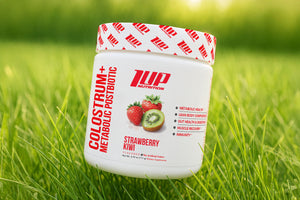Carbohydrates are one of the most polarizing topics in the realm of health and fitness.
Spend enough time reading blogs or social media posts and you will be convinced that carbs are:
- The key to muscle growth
- The culprit of fat gain and the obesity epidemic
- Delicious
- Spike insulin and cause diabetes
- Required for optimal performance and recovery
- Completely unnecessary and not an “essential” macronutrient
As you can see, there’s a lot of noise to work through in order to find a clear “signal” surrounding the truth about carbohydrates.
That’s where this guide comes in.
We’re going to tell you everything you need to know about carbohydrates -- the good, the bad, and the ugly -- as well as how they relate to the glycemic index and chronic lifestyle diseases like type 2 diabetes and metabolic syndrome.
So, without further adieu…
What Are Carbohydrates?
Carbohydrates are one of the three main macronutrients from which the body derives energy and nutrition (protein and fat, being the other two).
Carbohydrates are composed of various types of sugars (saccharides), including:
- Monosaccharides: glucose, fructose, and galactose
- Disaccharides: sucrose and lactose
- Polysaccharides: cellulose and starch
There are three main types of carbohydrates:
Sugar
Sugars are the most basic form of carbohydrates, hence their name as “simple” carbs.
While sugar has a negative connotation, the truth is that simple sugars are naturally occurring in many healthy foods, including fruits, vegetables, and dairy (milk, yogurt, etc.). The reason these simple sugars aren’t something to worry about is that they are also surrounded by a fiber matrix, which provides a slow, sustained release of energy into the bloodstream. And, they’re also found alongside countless antioxidants, polyphenols, and other bioactives that are known to support health and wellness.
Where sugar goes “bad” is when it’s added to processed foods. Research has shown a pretty clear link that consuming too much added sugar can lead to weight gain, type 2 diabetes, obesity.[1]
This is all the more alarming when you understand that obesity can significantly increase cancer risk.[2]
The bottom line here is that sugar in and of itself is not bad. Consuming fruits and veggies (both of which contain simple sugars) are one of the best things you can do.
It is the excessive consumption of simple sugars added to processed foods that lead to weight gain and high blood sugar levels that is the cause for concern.
Starch
Graduating from simple sugars brings us to starches, which are considered complex carbohydrates.
Starches are formed by linking together multiple sugar units.
They are found naturally in grains, legumes, and vegetables, including potatoes, lentils, quinoa, pasta, and bread.
The benefit of starch (and other complex carbohydrates) is that they require greater energy and effort to breakdown by the body, which means they provide a sustained release of energy and promote feelings of fullness.
Fiber
Fiber is the non-digestible carbohydrate component found in plant foods.
While fiber may not be able to be digested and utilized by the body, it does serve several important roles.
First, the bacteria lining our GI tract ferment (“digest”) fiber and use it as fuel to stay healthy.
Second, fiber slows down the digestion process, keeping you feeling full longer and providing a steady supply of energy to the bloodstream.
Third, fiber also adds bulk to your stool and supports gut motility and regularity.
Carbohydrates & Glycemic Index
The Glycemic Index (GI) is a relative ranking of how the carbohydrate in foods affect blood glucose levels. Foods with a low GI value (55 or less) are digested, absorbed, and metabolized more, causing a slower/lower rise in blood glucose as well as insulin levels.
On the flip side, foods with a high glycemic index (above 55) are digested, absorbed, and metabolized rapidly (relatively speaking), typically resulting in larger, faster spikes in blood glucose and insulin levels.
Research indicates that consuming a low glycemic diet may help improve overall health and lower the risk of diabetes, heart disease, and cardiovascular disease.[3,4]
However, while the glycemic index can be a measure of how “good” or “bad” a food is for you, it doesn’t tell the whole story.
For instance, the glycemic index of a food is determined by eating it in isolation on an empty stomach without any other type of food.
How often do you only eat one food like white rice, potatoes, or bread by itself on an empty stomach?
Moreover, the glycemic index doesn't take into account how much of a given food you’re actually consuming. The GI value of a food is determined by giving people a serving of the food that contains 50 grams of carbohydrate minus the fiber. Researchers then measure the impact of that food eaten in isolation on subjects’ blood glucose levels over the next two hours.
Again, this isn’t that applicable to the real world.
More often than not, you’re consuming a carbohydrate-rich food alongside foods containing protein and/or fat.
For example, you’ll have a baked potato alongside a chicken breast or piece of grilled steak (and hopefully a salad or some other type of green vegetable).
The more protein, fat, and fiber a meal contains, the lower the glycemic index will be.
So, while glycemic index might be useful for helping you identify better food options, it’s not a perfect barometer for food choices or their impact on your body composition and/or metabolic health.
A superior alternative to the glycemic index is the glycemic load (GL)
GL addresses the shortcomings of the glycemic index by combining portion size and a food’s glycemic index into one number. A given food’s carbohydrate content of the actual serving is multiplied by the food's GI, then that number is divided by 100.
As a general rule of thumb, a glycemic load greater than 20 is considered high, between 11 and 19 is considered moderate, and 10 or less is considered low.
Now, let’s look at how carbohydrates relate to insulin and Type 2 Diabetes.
Carbohydrates, Diabetes, & Insulin
Starting at the top, insulin is a peptide hormone whose most well known function is to regulate blood glucose levels by facilitating glucose uptake into your cells.[5]
Insulin also:
- regulates carbohydrate, protein, and lipid metabolism
- promotes cell division and growth (via mitogenesis)
- decreases the rate of fatty acid oxidation in muscle and liver (i.e. reduces fat burning)
- increases the rate amino acid delivery into tissues,
- increases the rate of protein synthesis in muscle (i.e. builds muscle), adipose tissue, liver, and other tissues
- decreases the rate of protein degradation in muscle (i.e. stops catabolism, “muscle breakdown”)
- decreases the rate of lipolysis in adipose tissue
- decreases the rate of glycogen breakdown
Now, it’s typically thought that only carbohydrates (glucose) causes insulin levels to rise, but protein also stimulates the release of insulin.
As we mentioned, the main function of insulin is to maintain blood sugars in the “steady” range, which is between 80-100 mg/dl. In the instance that blood glucose levels rise above 100 (i.e. you eat a carb heavy meal), the pancreas secretes insulin to “pick up” the extra glucose floating in your blood and store it in one of three places:
- Muscle glycogen
- Liver glycogen
- Adipose tissue
Note: ideally we’d want all of this glucose to be stored in muscle glycogen or the liver, but that’s not always the case, especially when glycogen stores are already full.
Now, in regards to diabetes, there are three main types:
- Type 1 Diabetes
- Type 2 Diabetes
- Gestational Diabetes
Type 1 Diabetes is an auto-immune condition where the body’s immune system attacks and destroys the beta cells in the pancreas that produce insulin.
Type 2 Diabetes is lifestyle driven and begins with insulin resistance. Essentially, cells become resistant to insulin, which forces the pancreas to produce more insulin up until the point where the pancreas can no longer meet demand, resulting in decreased insulin production and elevated blood glucose levels.
Gestational diabetes only occurs during pregnancy and is caused by insulin-blocking hormones. Generally, this condition subsides post-partum.
The primary concern of this article is Type 2 diabetes, which is brought on from a combination of poor diet (high is calories, sugar, and refined carbs), lack of physical activity, and excessive body fat.
As we mentioned above, in type 2 diabetes, cells become resistant to insulin, leading to hyperglycemia (high blood sugar). When this hyperglycemic state becomes chronic, glucotoxicity ensues, leading to the degradation of organs and tissues in the body.
While all of this may lead you to start thinking that carbohydrates and insulin are the “bad guys”, the reality is that both carbohydrates and insulin serve important purposes.
Research has shown that in healthy (non-diabetic) individuals, higher insulin levels and sensitivity are associated with greater amounts of lean body mass.
Furthermore, intense exercise (resistance training, sprinting, HIIT, etc.) increases insulin sensitivity, such that in the post workout period, skeletal muscle tissue is primed to absorb any and all glucose (carbs) thrown its way to support muscle recovery and glycogen replenishment.
As you can see, it’s not carbohydrates or insulin that is the bad guy.
It is a sedentary lifestyle coupled with poor nutritional choices.
With that said, let’s now look at some of the benefits of keeping carbohydrates in the diet.
Benefits of Carbs
- Better performance
- Greater endurance
- Enhanced intra-set recovery
- Faster recovery between workouts
- Combats muscle breakdown (catabolism)
- Increases training capacity (volume of work you can handle)
Optimizing Carbohydrate Intake
To get the most from your carbohydrate intake as well as support weight loss, performance, and metabolic health:
- Incorporate a variety of whole plant based foods This includes, beans, peas and lentils, raw or steamed fruits and vegetables and whole grains.
- Limit added sugars and processed foods
Beyond that, if you’re looking to implement more carbohydrate immediately before, during, or after training to support performance, recovery, and growth, check out 1UP Tri-Carb.
Each serving of Tri-Carb supplies 25 grams of high-performance carbohydrates in Cluster Dextrin®, Carb10™ & MODCARB® to enhance athletic performance, support energy production, and aid glycogen replenishment.
Tri-Carb is unflavored, mixes easily, and can be added to your pre workout, intra workout, or post workout shake.
References
- Basu S, Yoffe P, Hills N, Lustig RH (2013) The Relationship of Sugar to Population-Level Diabetes Prevalence: An Econometric Analysis of Repeated Cross-Sectional Data. PLOS ONE 8(2): e57873.https://doi.org/10.1371/journal.pone.0057873
- Basen-Engquist K, Chang M. Obesity and cancer risk: recent review and evidence. Curr Oncol Rep. 2011;13(1):71-76. doi:10.1007/s11912-010-0139-7
- Brand-Miller J, Hayne S, Petocz P, Colagiuri S. Low-glycemic index diets in the management of diabetes: a meta-analysis of randomized controlled trials. Diabetes Care. 2003;26(8):2261-2267. doi:10.2337/diacare.26.8.2261
- Brand-Miller JC, Holt SH, Pawlak DB, McMillan J. Glycemic index and obesity. Am J Clin Nutr. 2002;76(1):281S-5S. doi:10.1093/ajcn/76/1.281S
- Dimitriadis, G., Mitrou, P., Lambadiari, V., Maratou, E., & Raptis, S. A. (2011). Insulin effects in muscle and adipose tissue. Diabetes Research and Clinical Practice, 93 Suppl 1, S52-9. http://doi.org/10.1016/S0168-8227(11)70014-6






